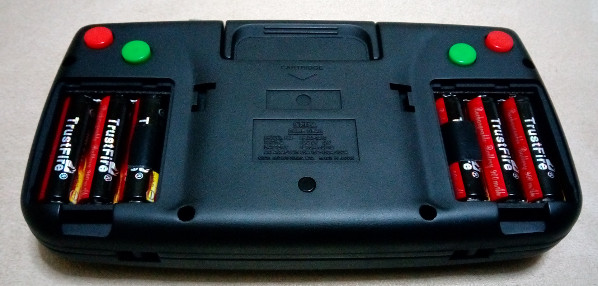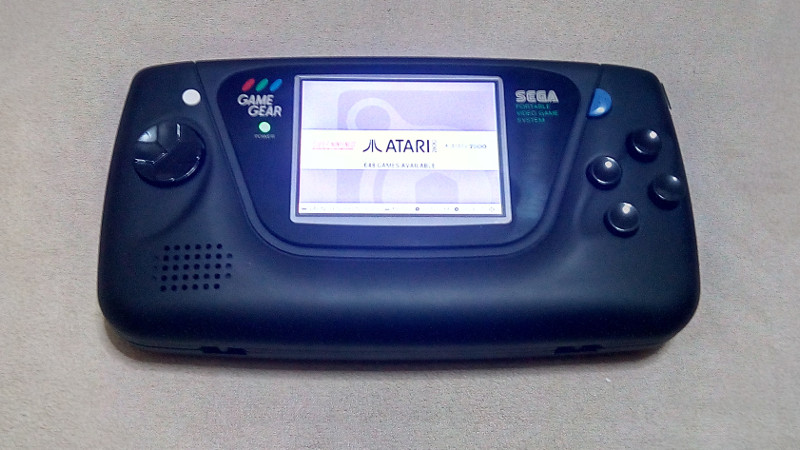If you were a gamer in 1991, you were presented with what seemed like an easy enough choice: you could get a Nintendo Game Boy, the gray brick with a slightly nauseating green-tinted screen that was already a couple of years old, or you could get yourself a glorious new Sega Game Gear. With full color display and games that were ported straight from Sega’s home consoles, it seemed like the Game Gear was the true future of portable gaming. But of course, that’s not how things actually went. In reality, technical issues like abysmal battery life held the Game Gear back, and conversely Nintendo and their partners were able to squeeze so much entertainment out of the Game Boy that they didn’t even bother creating a true successor for it until nearly a decade after its release.
While the Game Gear was a commercial failure compared to the Game Boy back in the 1990s and never got an official successor, it’s interesting to think of what may have been. A hypothetical follow-up to the Game Gear was the inspiration for the SegaPi Zeo created by [Halakor]. Featuring rechargeable batteries, more face buttons, and a “console” mode where you can connect it to a TV, it plays to the original Game Gear’s strengths and improves on its weaknesses.
As the name implies the SegaPi Zero is powered by the Raspberry Pi Zero, and an Arduino Pro Micro handles user input by tactile switches mounted behind all the face buttons. A TP4056 charging module and step-up converter are also hiding in there, which take care of the six 3.7 lithium-Ion 14500 batteries nestled into the original battery compartments. With a total capacity of roughly 4,500 mAh, the SegaPi Zero should be able to improve upon the 3 – 4 hour battery life that helped doom the original version.
There’s no shortage of projects that cram a Raspberry Pi into a classic game system, but more often than not, they tend to be Nintendo machines. It could simply be out of nostalgia for Nintendo’s past glories, but personally we’re happy to see another entry into the fairly short list of Sega hacks.

















6x 3.7V lithium-Ion 14500 batteries, total ~4500 mAh according to the article (700-800 mAh per battery, in parallel).
So about ~16.5 Wh for a meaningful number!
Let’s say the Pi Zero under full load requires about 250mA at 5V, so 1.25 Watt, that would make the batteries last somewhere around ~13 hrs.
impressive.
screen is gonna eat power too
good point, totally forgot about the screen.
But because trustfire lies alot about thier rated capacity, divid that number by at least 2
Any brand ending with “fire” should be divided by 4-10 to get real capacity. Best practice is to test it with charger with discharge&measure feature.
I’m amazed at the fake capacity chinese seller are now advertising. When I looked at it a few years ago, they advertised 18650 batteries with a (fake) capacity of 4Ah, but now they’re even showing 12Ah batteries !
I’m pretty sure I will see 20Ah marked 18650 batteries in a year or two.
(A real brand 18650 battery is between 2.0 – 3.0Ah)
Memory fuzzy (yes I had a GG), but I seem to remember there was another handheld console other than those two.
The Atari Lynx and Wonderswan spring to mind, though I’m sure there were more also-rans.
Well, now that I check, the Wonderswan was late 90s and Japan-only
Turboexpress. A portable TurboGrafx-16 but it had the smallest screen of the 4 portable consoles and the biggest price tag at around $400. AFAIK Atari Lynx was the first color portable to come out, before Game Gear and Lynx was capable of unlimited sprites and some rudimentary 3D effect that even Game Gear can’t achieve, Poor battery life (like GG and TE) plus lack of backward compatible support meant those who adopted Lynx early on was limited to a handful of games while GG with Master Gear converter and TE without needing adapter could play 100’s of existing games early on.
Gameboy however won out the first round of portable game war. They were cheap, lasted longer on batteries, and you can’t beat Tetris pack in game at all!
PS none of those can rightfully claim to be first ever cartridge based portable system. Microvision came out a decade earlier but suffered and died with just a handful of game titles released. The LCD wasn’t well made and prone to rotting and not many Microvision are left with working display. People over at AA forum are trying to cook up a replacement LCD using modern LCD panel that is readily available like a Nokia type, a FPGA to convert the original data signal into 16×16 map and divide the new LCD into same 16×16, and backlight support. Making new games are rather hard because of unusual design, Milton Bradley choose for some dumb reason to have CPU with internal PROM on the cartridge rather than CPU on the main unit and ROM on the cartridge. I don’t know if compatible CPU can be sourced today.
It wouldn’t be authentic, but it seems like an LED matrix might be a reasonable alternative to the LCD.
Do we actively know what the 6-bit interface is? The summaries I’ve found insinuate that the game manually clocks out values for the row and columns directly, and somehow separately specifies the field inversion, but that 6-bit interface isn’t exactly well documented.
@rnjacobs I don’t know the specific on how LCD is addressed but LED was discussed and shot down. For one thing, where would you find a 16×16 LED matrix that is about 1.5″ diagonal and not expensive? Second, it’d be pretty bright and not good for eyes when playing in the dark. LCD aren’t so bright, black and silver like original, and readily comes in that size.
Ah, now I’ve found the thread on AA. Here Unsurprisingly, kevtris already has all the facts lined up.
SEGA Nomad. The only portable that could use the same cartridges as a console. Could use the Nomad’s built in screen or connect it to a TV and a second controller for 2 player games. Similar sucky battery life to the Game Gear.
Turboexpress could use same game card as TurboGrafx-16 and that one came out a few years before Nomad. Did not have TV out though.